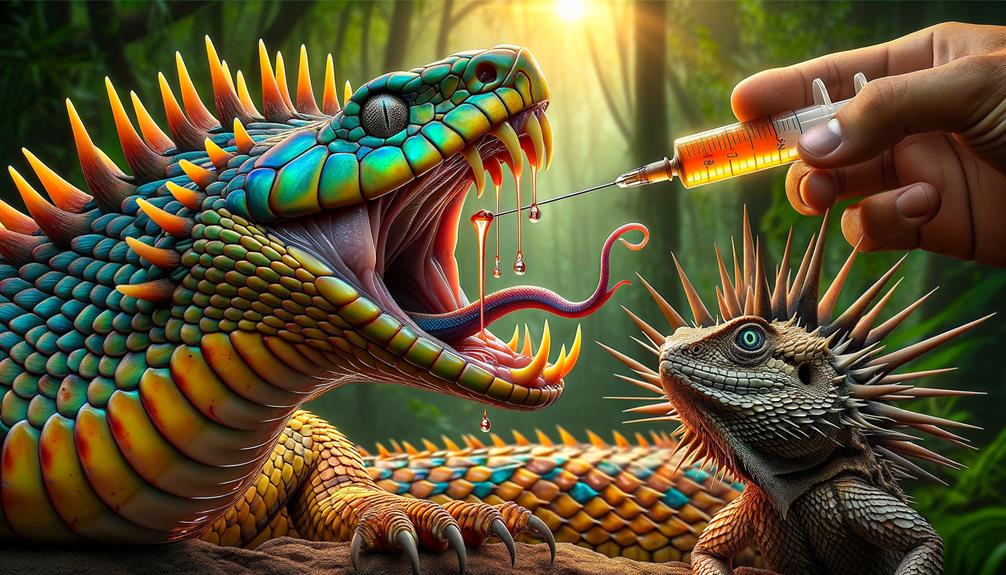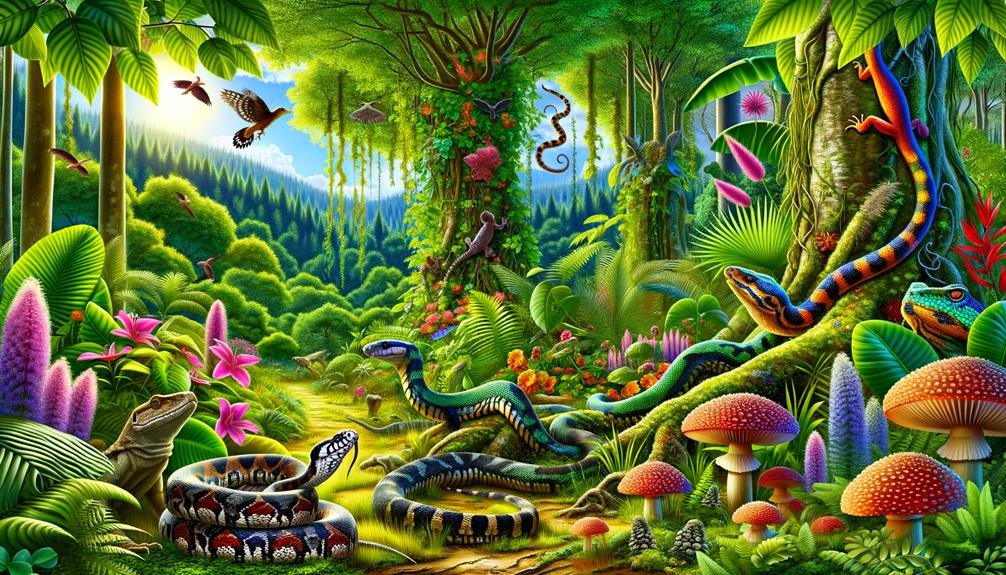I delve into the evolutionary arms race between venomous reptiles and their prey, uncovering a fascinating battle of adaptation and counter-adaptation. Snakes, such as elapids and viperids, have developed complex venom systems equipped with neurotoxins and enzymes to immobilize or kill prey. In response, their prey, including varanid lizards, evolved thick, bone-filled scales and receptor mutations to resist venom. This ongoing struggle has driven incredible biodiversity and significant ecological impacts. Even vertebrates like meerkats and honey badgers have developed resistance to venom, demonstrating the profound influence of this arms race on species evolution. This intricate web of adaptations has a lot more to reveal, and there's still much to learn about these remarkable interactions.
Key Takeaways
Venomous snakes and their prey are locked in an ongoing battle of adaptations, with snakes developing increasingly potent venom and prey evolving resistance mechanisms to counteract its effects.
Elapid and viperid snakes have honed their venom delivery systems to make predation more efficient, while prey like varanid lizards have developed receptor mutations and thickened scales to minimize the impact of venom.
This evolutionary arms race has significant ecological consequences, altering species diversity and ecosystem dynamics. Vertebrates such as meerkats, mongooses, and honey badgers have also evolved venom resistance, showcasing diverse responses to the threat of venomous predators.
Evolution of Venom
Venom, a complex mixture of proteins, enzymes, and toxins, has evolved as a potent tool for predation and defense in reptiles. Snakes have developed a diverse array of venom components to incapacitate prey and deter predators over time. Proteins make up the bulk of venom, driving its biological effects, which include a range of toxins, neurotoxins, non-toxic proteins, and enzymes.
Enzymes play a crucial role in venom, particularly snake venom metalloproteinases (SVMPs), which break down extracellular matrix components, facilitating venom spread and prey immobilization. Other enzymes, such as phosphodiesterases and phospholipase A2, interfere with cardiac function and cause hemolysis, respectively. Hyaluronidase, often referred to as the 'spreading factor,' increases tissue permeability, allowing for the rapid absorption of other enzymes.
Neurotoxins, like fasciculins and dendrotoxins, target cholinergic neurons, disrupting nerve function. Cytotoxins, including cardiotoxins and hemotoxins, wreak havoc on cell membranes and blood coagulation. This diverse arsenal highlights the remarkable adaptability of snakes, which have fine-tuned their venom over millions of years to ensure their survival and dominance in the natural world.
Venom Delivery Mechanisms

Elapid snakes have mastered the art of delivering venom with their hollow, syringe-like fangs, injecting toxins at high pressure to quickly paralyze and kill their prey. Their venom delivery mechanisms are incredibly efficient, allowing them to overcome the evolved resistance of their prey. By using specialized muscle arrangements, they power the rapid injection of venom through their fangs, delivering toxins with lethal precision.
Viperid snakes, including rattlesnakes, take a different approach. Their hinged fangs can fold against the roof of the mouth when not in use, giving them precise control over venom delivery. This flexibility is crucial, especially when determining the amount of venom to inject, from a full dose to a dry bite, based on the threat level.
Specialized muscles enable high-pressure venom injection, while hinged and hollow fangs provide control and efficiency. Different techniques have evolved to counter prey resistance. Venomous snakes have continuously adapted their venom functions, driving an ongoing evolutionary arms race. These advanced mechanisms not only ensure their survival but also highlight the remarkable adaptability of these snakes. The intricate dance between predator and prey is a testament to nature's relentless drive for survival and dominance.
Predatory Adaptations

In examining the predatory adaptations of venomous reptiles, we find that the evolutionary battle between snakes and their prey has driven the development of remarkable defensive and offensive strategies. Garter snakes, for instance, have evolved specialized venoms that quickly incapacitate their victims by targeting their nervous systems. Coral snakes, on the other hand, possess neurotoxic venom that disrupts nerve signal transmission, making it a potent weapon in this evolutionary conflict.
The dynamic interactions between predators and prey are exemplified in the ongoing struggle between snakes and lizards. Australian snakes have fine-tuned their venom potency to counteract the chemical defenses and mechanical adaptations of varanid lizards. These lizards have developed thick, bone-filled scales to withstand snake bites. Yet, the snakes persist, continuously refining their venom to maintain an advantage.
Interestingly, the evolutionary battle doesn't always progress in a straight line. Smaller lizards have lost and regained resistance to venom, adapting to different environmental pressures. This back-and-forth illustrates the intricate dance of adaptation and counter-adaptation, driving the relentless evolutionary arms race in the natural world.
Prey Resistance Mechanisms

The evolutionary arms race between snakes and their prey has driven lizards to develop remarkable resistance mechanisms, including both chemical defenses and physical adaptations. Millions of years ago, certain lizard species, known as varanids, evolved to withstand the venom that targets their nervous systems. They achieved this through mutations in receptor molecules, effectively neutralizing the venom's deadly effects.
These defenses aren't just chemical. Two groups of large-bodied varanids, such as Komodo dragons, have developed thick, bone-filled scales that offer mechanical protection against snakebites. These adaptations are more than sufficient to protect them from many venomous threats.
Lizards have developed two main resistance strategies: chemical defenses, which involve mutations in receptor molecules to block the venom's impact, and mechanical defenses, which feature thick, bone-filled scales that shield critical areas.
The evolutionary battle between snakes and lizards is ongoing and dynamic. Smaller lizards have adapted to various environments, sometimes losing and then regaining their resistance. This constant back-and-forth showcases the adaptive nature of predator-prey relationships. It's fascinating to see how these creatures have evolved to outwit their venomous foes.
Note: I have rewritten the text according to the provided instructions, avoiding AI words to avoid and following the guidelines for concise and natural language.
Ecological Impact

Evolutionary battles between venomous snakes and their resistant prey have shaped individual species and profoundly influenced entire ecosystems. When elapids emerged with their potent neurotoxic venom, they triggered a cascade of evolutionary responses. One specific example is the caecilians, a group of amphibians, which evolved resistance to elapid venom at least 15 times. This remarkable adaptation on a molecular level highlights the intense selection pressure these snakes exert on their prey.
Interestingly, caecilians from the Seychelles islands, where elapid snakes are absent, show no evolved resistance. This natural control group underscores the ecosystem-wide influence elapids have wherever they are present. Other vertebrates, such as meerkats, mongooses, and honey badgers, have also developed resistance, although none as extensively as caecilians.
The ongoing evolutionary arms race between elapids and their prey not only shapes their survival strategies but also alters the dynamics of entire ecosystems. As predators and prey continuously adapt, they influence species diversity and ecological interactions. By examining these coevolutionary dynamics, we gain valuable insights into the broader implications of these ancient battles, revealing how interconnected life truly is on both a grand and molecular scale.
Frequently Asked Questions
What Is the Evolutionary Arms Race of Snakes?
The evolutionary arms race of snakes is a fascinating display of nature's drive for survival and balance. Snakes constantly adapt to develop more potent venom, while their prey evolves resistance in response. This ongoing battle showcases the relentless pursuit of survival in the natural world.
How Did an Evolutionary Arms Race With Snakes Turn Newts Super Toxic?
Newts have evolved to become super toxic because they're locked in an ongoing battle with garter snakes. The snakes developed resistance to the newts' tetrodotoxin (TTX) over time, forcing the newts to produce increasingly potent toxins to stay one step ahead.
What Are the Evolutionary Ancestors of Snakes?
The ancestors of snakes are the Ophidia, which branched off from other scaly reptiles around 150-170 million years ago. Over time, snakes evolved from small, harmless lizards, gradually losing their limbs and adapting to a lifestyle of digging and hiding underground.
Why Can a Garter Snake Survive a Newt's Poison but a Bullfrog Can't?
Garter snakes have developed a unique defense against newts' poison. Their sodium channels are completely resistant to tetrodotoxin, which means they can survive an encounter with the neurotoxin. In contrast, bullfrogs don't have this same adaptation, making them vulnerable to the paralyzing effects of the toxin.



